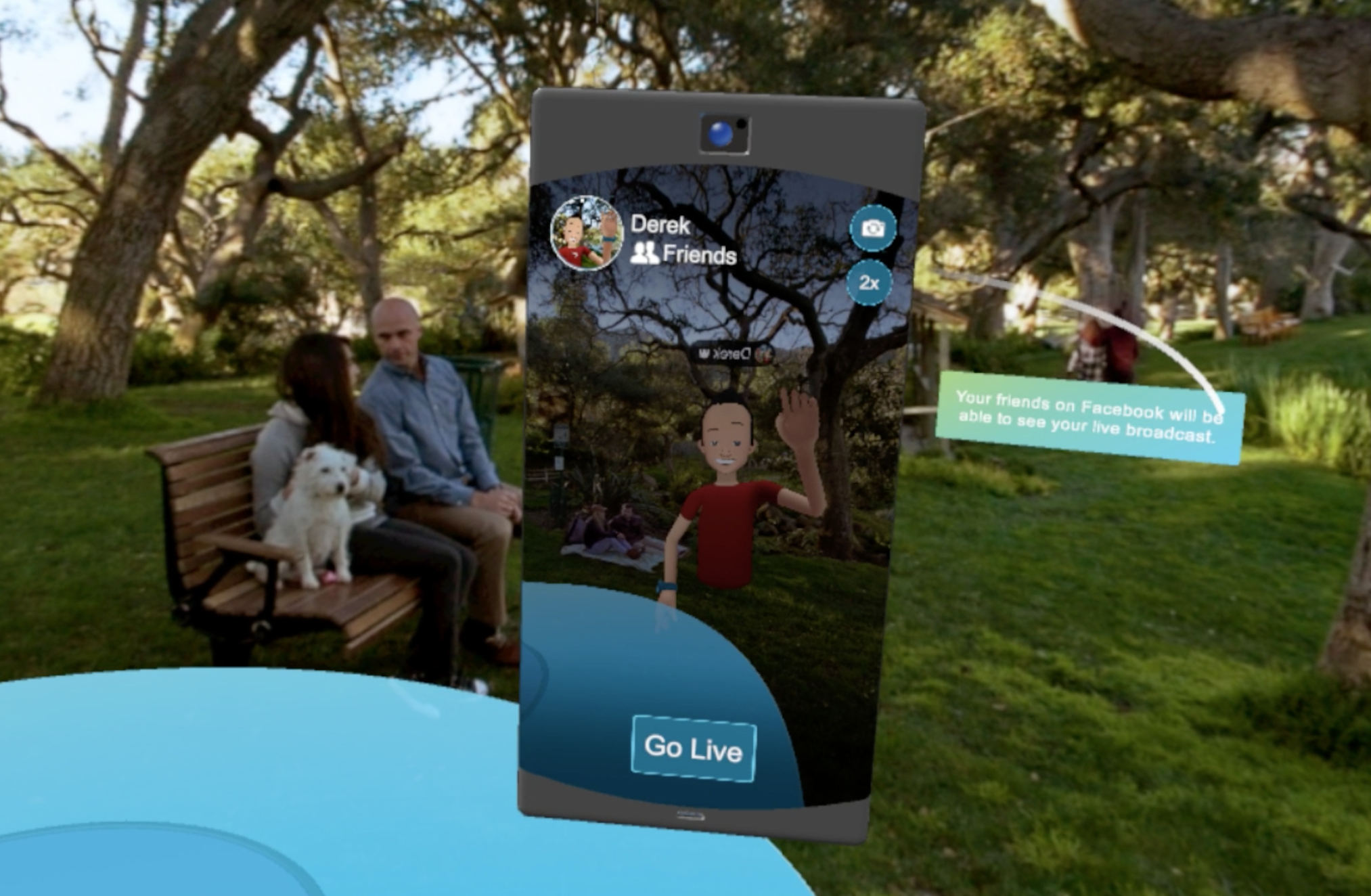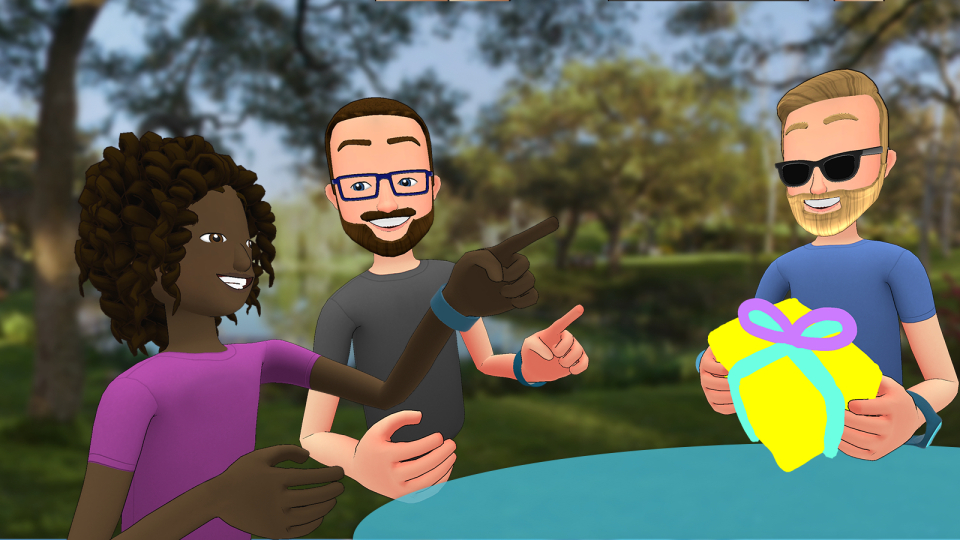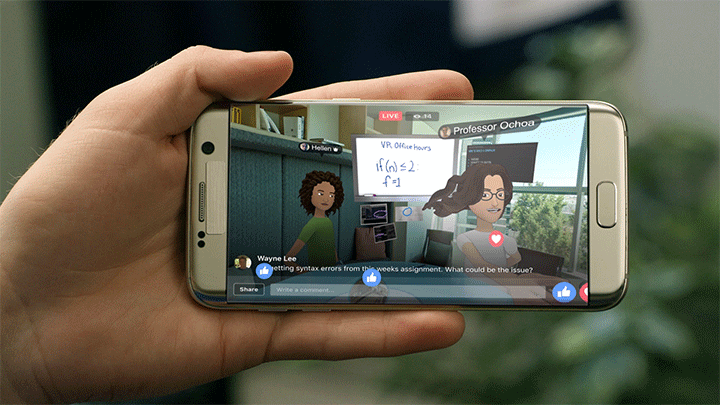
Last week I logged into my Facebook account to chat with some friends and browse through photos and videos, as any one of Facebook’s fellow 1.32 billion daily users do. But I wasn’t looking at photos on my phone or computer.
A cartoonish avatar hovered to my left. “Where do you want to go?” he asked. “How about scuba diving?” Seconds later, a tiny orb that looked a bit like a virtual snow globe only with an aquatic backdrop inside appeared before me. I grabbed it, brought it as close to my face as I could (so close, in fact, that I accidentally bonked myself). And just like that, my virtual friend and I were deep underwater, encircled by sharks.
Facebook CEO Mark Zuckerberg hasn’t shied from rhapsodizing virtual reality since the social media behemoth purchased Oculus VR for $2 billion in March 2014. “This is really a new communication platform,” wrote Zuckerberg in his note announcing the acquisition. “By feeling truly present, you can share unbounded spaces and experiences with the people in your life.” But enthusiasm for bleeding-edge tech intended to leap the fence dividing niche curiosity from consumer fixation comes with a price tag. In court testimony earlier this year, Zuckerberg said his company would probably have to invest more than $3 billion in VR over the next decade to get the technology where Facebook wants it to be.
Spaces, Facebook’s social virtual reality app for the Oculus Rift that’s currently in beta, appears to be the culmination of those efforts so far. Although Facebook has supported 360-degree video since late 2015, Spaces feels like the first real effort by Facebook to create an environment built specifically for VR. It’s also an answer to two of the biggest problems facing the VR industry: adoption is slow, and the experience itself is isolating. Facebook wants Spaces to establish that VR isn’t just gamers and tech enthusiasts. “We really want people outside of VR to feel like it’s for them,” says Rachel Franklin, Facebook’s head of social VR who previously worked on The Sims at Electronic Arts.
Facebook is just one of several companies attempting to boost VR adoption by eliminating hurdles. Microsoft, while not as focused on the social aspect of VR, created a revamped version of Windows 10 tooled specifically for virtual and augmented reality. Startup Altspace VR, though recently forced to shutter over financial difficulties, created a virtual social network so popular it inspired a real wedding hosted in VR. Even the creators of Second Life, that practically prehistoric virtual life simulation, are getting in on the action: Linden Lab launched a beta for its new virtual reality world Sansar at the end of July.
Facebook hopes to leverage its massive social leg up to craft the ultimate communal experience in imaginary space. Yes, you can create digital sketches, browse your photos and Timeline, and view 360-degree videos. But the upshot is both subtler and, over time, more powerful: the sense that you’re actually hanging out with close friends and family.
Spaces is meant to be a virtual hangout where you can kick back with up to four friends, each represented by self-created digital avatars. You can also video chat with friends through Facebook Messenger in Spaces, start a Facebook Live broadcast and capture a virtual selfie with a selfie stick. “Everything we do should really be facilitating your interaction with someone else, or enhancing that relationship somehow,” says Franklin.

It’s still early days for Spaces; the app, unveiled in April at the company’s F8 conference, is still in beta. And it’s impossible to say whether Facebook can deliver the sort of breakthrough experience VR needs to go wide. Based on my limited time with the app, its most enthralling parts seem less its virtual social interactions than how different Facebook content feels when you’re experiencing it in full wraparound space.
As capturing 360-degree footage increases, and especially as cameras capable of doing so drop in price, I can imagine Spaces becoming a compelling way to relive milestones or experience events people couldn’t in person. Instead of just looking at photos from a friend’s wedding I missed, I could see myself strapping on a headset and watching a 360-degree video from the maid of honor’s perspective. That kind of experience is possible today without Spaces, but Facebook’s scale and reach could so streamline the process that Spaces becomes the premium way to experience and share this kind of virtual reminiscing.
While the content is still the most exciting part, it’s also clear that Facebook is rethinking how interactions should work in a medium that doesn’t rely on swiping, tapping, clicking, or scrolling. Switching between your Timeline, photos and different virtual environments requires a lot of poking buttons and grabbing at virtual objects. When I high-fived my friend’s avatar, an explosion of Facebook’s Reaction symbols emerged from our hands. When I reached for the selfie stick, my avatar knew to smile. Facebook’s Franklin expects these interface tweaks to be an ongoing challenge guided by experimenting. “I think there’s a lot of things we’ve done really well, and there’s a lot where we’re just learning,” she says. “It’s a matter of, what do we stick with because you know it and what do we teach you? And I don’t think we’ve quite found that right balance.”

While the avatars in Spaces may not feel as personal as video chatting with someone (it’s not possible to make eye contact or see their true facial expressions) the app does address VR’s isolation problem. As I wrote in my original review of the Rift, it’s an experience that’s difficult to share with those to haven’t tried it themselves. You can smile, laugh and gawk all you want while wearing the Rift, but those signals don’t convey exactly what you’re experiencing. Spaces solves at least part of that problem by making it possible to enjoy the same VR video with any Facebook friend that owns a virtual reality headset.
Improving how realistic Spaces feels will partially involve making the avatars more detailed and broadening the customization options available. I couldn’t, for example, make an avatar that truly looked like me because there was no shade of red that came close to my hair color. Facebook is working on tackling problems like these: The team in charge of designing Spaces’ avatars not only takes into account body language and facial expressions, but also debates what types of accessories and articles of clothing should be available in order to accurately represent everyone. One particular discussion centered on whether or not headdresses should be available for avatars. “One of our team members wears a turban and he said, ‘I can’t feel like myself testing our own product if I can’t make myself. Let’s put this in,'” says Franklin. “And we said absolutely, we need to.”
Headsets like the Rift and HTC Vive have been available for roughly a year and a half, and companies like Facebook and Intel are already thinking about what’s next. Facebook has said it’s working on a new wireless headset that would include all of the necessary tracking components baked in without need for external cameras. Such developments are important for the Spaces team to keep in mind as it continues to develop the app.”It’s more of a conversation right now, and we’re trying to help guide each other when we’re thinking long term,” says Franklin of the relationship her team has with Oculus chief scientist Michael Abrash’s research and development department.
Spaces may not be the most intimate or convenient way to communicate with the people you care about. But it made for a momentous first: When I removed my headwear after the Spaces demo, I was able to look at the person standing next to me and know he had the exact same experience I did. This may explain why Franklin isn’t fretting over the way Spaces’ avatars only look abstractly like the people they represent. “I can see your body language, and I can read that,” she says. “It doesn’t have to be hyper-realistic for it to feel real.”
More Must-Reads from TIME
- Donald Trump Is TIME's 2024 Person of the Year
- Why We Chose Trump as Person of the Year
- Is Intermittent Fasting Good or Bad for You?
- The 100 Must-Read Books of 2024
- The 20 Best Christmas TV Episodes
- Column: If Optimism Feels Ridiculous Now, Try Hope
- The Future of Climate Action Is Trade Policy
- Merle Bombardieri Is Helping People Make the Baby Decision
Contact us at letters@time.com